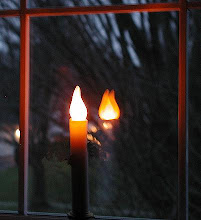Wednesday, February 09, 2011
Little Green Men
Among mediaeval church carvings we find the heads of men surrounded in foliage, sometimes growing from their mouths, eyes and ears. According to Sir Geoffrey Grigson, this foliage is often recognizable as hawthorn or oak, and the face has an expression of a decided frown, or an expression fit to an unhappy state. (Nowadays we tend to put a smile on his face in pictures.)
Some scholars have "rationalized" these images by explaining that they stand for Easter and Resurrection, or that they are genii of the Spring and the Planting. I find it hard to understand why such a supernatural "genius" would plant hawthorn in its mouth, but I never put forward such "rationalizations".
Such images are the Green Men, the Man-in-the-Oak, or Jack-in-the-Green, who himself is the May King of the common May Day ceremonies of great age, a man who would play King and wreathed himself in leaves and flowers and acted out a death, and then came back to life, jumping up and gamboling and comforting his disconsolate May Queen, and dancing with her.
I wonder if this image appears in the yet more ancient cave paintings in a somewhat more lascivious form?
There are many pubs in Britain named after the Green Man. This is part of our history. We have pretty much forgotten it. When I forget history, I am left speechless. The words flow, but nothing comes out except an endless carpet of verbiage with a border selvage of incomprehension.
--
Subscribe to:
Post Comments (Atom)


















No comments:
Post a Comment